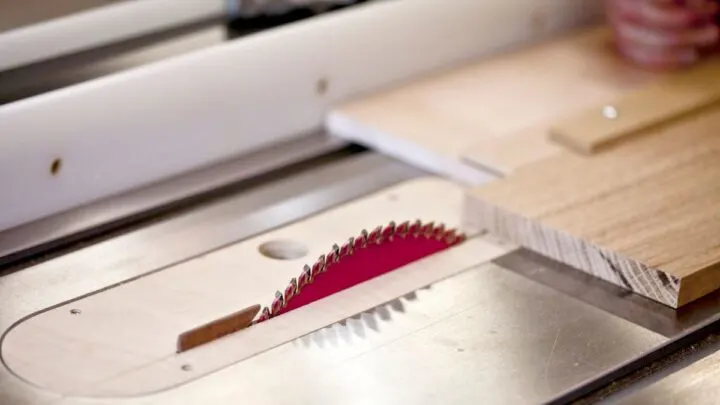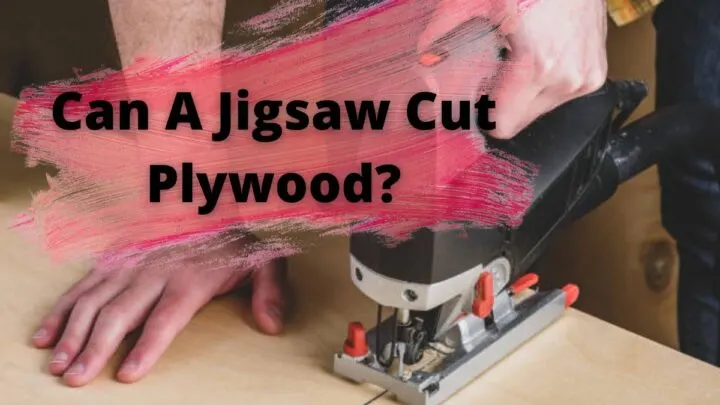Jigsaws are powerful tools designed to cut through different types of materials. They make cutting easy and quick. But can a jigsaw cut plywood?
It might sound obvious that a jigsaw can cut plywood. After all, what else is a saw used for other than cutting wood? But cutting plywood is not as simple as it sounds.
A jigsaw is an excellent tool for cutting plywood. But using a jigsaw on plywood requires experience and the correct technique; otherwise, you may encounter poor cuts and splintering.
Cutting plywood with a jigsaw can be tricky because the wood will quickly tear up and splinter if the correct blades, tools, and techniques are not used.
Woodworking experts love to use jigsaws to cut all types of wood. However, beginners are recommended to practice on test pieces of plywood before moving onto the actual workpiece.
Plywood is prone to tearing and splintering, and you can quickly ruin the piece if you do not select the correct blades, speed, and other equipment.
Can A Jigsaw Cut Plywood?
A jigsaw can make both curves and straight-line cuts on sheets of plywood. The jigsaw makes cutting wood convenient and versatile.
Other tools can make cutting more precise, such as a table saw, but the flexibility that a jigsaw offers makes it stand out.
There are a number of challenges that you can come across when cutting plywood, however.
Handling large sheets of plywood can be difficult because of their size and weight and because the longer your cuts, the more the chances of things going wrong.
A prevalent issue is tearing and splintering, and there are many reasons why plywood may give way.
What Is Splintering?
When cutting through plywood, you will sometimes notice that a thin layer breaks off from both edges along the cut being made.
The layer pops up and takes a serrated and rough form. This happens because plywood is composed of multiple grains.
As the blade runs along these grain marks, some grains pop out, making the cut appear like a tear.
Why Is Splintering Bad?
To begin with, splintering looks unprofessional. Another reason is that it can cause further damage to the plywood.
Leaving torn out or splintered parts as they are can lead to the following issues:
- They can quickly expand, causing damage to a much larger portion
- You cannot apply glue or stick two parts of the wood together if they have splinters
- If you try to pull the splinters out by hand, you will end up causing larger tears along the surface of the plywood.
Reasons for Splintering
There are several reasons that plywood can splinter. However, the following four are the most common ones.
1. Using Low-Quality Plywood
Using plywood that is too thin or of low quality is one of the main reasons for having it become torn.
These types of plywood have thin and weak fibers, which are more prone to tearing out with the reciprocating motion of the saw blade.
2. Speed of Cutting
If you run your jigsaw like a Ferrari, you will lose control. It is advised to avoid using the power tool at higher speeds if you want to get good results.
Running the machine too fast will cause the cuts to be uneven and lead to tear outs. This happens because the blade will move up and down more than deeper into the cut.
As it rapidly slides against the edge of the cut, it can pull out any fibers that may get stuck onto the sides of the teeth.

3. Incorrect Saw Blades
A wrong sawblade will get you nowhere except to damaging your wood. There are so many things that can be wrong with your blade.
These include the thickness, the material, and the teeth type and direction. Using the wrong kind of blade will often lead to tear-outs.
4. Not Being Patient
Sometimes, we cannot wait to plug that jigsaw in and get to work, especially if the tool is new or we are beginners.
However, lack of preparation can quickly backfire and can cause damage to the wood, the jigsaw, and even us.
How To Prevent Splintering
Now that we know what causes splintering, let us look at a few tips and tricks that you can use to minimize the chances of tear outs.
1. Use The Correct Blade
Plywood is weak and sensitive, so it requires sharp and thin blades, which cut precisely with each stroke.
It is recommended to use the correct blade with higher TPI and teeth pointing upwards. Using a fresh blade will limit splintering as it is sharper and will make more precise cuts.
2. Use Good Quality Plywood
As discussed above, poor-quality plywood is more prone to splintering.
Even if you use the best tools, poor-quality wood can quickly ruin your project. It is best to use high-quality and thicker plywood for your projects.
3. Use Masking Tape
The simplest and probably the most commonly used technique to control splintering is masking tape. All you have to do is place a strand of masking tape along the cutting path, and you are good to go.
Masking tape will prevent the fibers from tearing off as the blade slides through the cut, keeping your plywood splinter-free.
4. Use A Splinter Guard
A splinter guard can be of great help, especially if you are a newbie. You need to replace the wicker with a splinter guard and cut away.
The guard will keep the wood flat and ensure that the fibers don’t come off.
5. Cut From The Edge if Possible
One of the most common reasons for splintering is when you use a jigsaw to start cutting the wood in the middle.
It is always better to start from an edge and go slow and steady without forcing the jigsaw along with the cut.
If you need to cut out a hole in the plywood, start by drilling a hole and placing the blade in the hole to begin cutting.
Relying on the pointy end of the blade to make its way through the plywood can often lead to splintering.
Summing Up If Jigsaws Can Cut Plywood
Jigsaws are a great tool in order to cut and size down plywood. The only catch is that you have to be careful with the tool and make sure you don’t splinter the wood or otherwise damage yourself in the process.
Using the wrong saw blade or being too hasty can lead to splintering and damage. Make sure you take your time and research what you need to do before you start.


